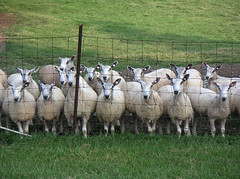|
While sheep and goats have many similarities, their taxonomy (scientific clasification) eventually diverges. Each is a distinct species and genus. Sheep (Ovis aries) have 54 chromosomes, while goats (Capra aegagrus hircus) have 60. While sheep and goats will occasionally mate, fertile sheep-goat hybrids are rare. Hybrids made in the laboratory are called chimeras. Look at their tails The easist way to tell the difference between a sheep and goat is to look at their tails. A goat's tail goes up (unless it is sick, frightened, or in distress). Sheep tails hang down and are often docked (shortened) for health and sanitary reasons. Foraging behavior A big difference between sheep and goats is their foraging behavior and diet selection. Goats are natural browsers, preferring to eat leaves, twigs, vines, and shrubs. They are very agile and will stand on their hind legs to reach vegetation. Goats like to eat the tops of plants. Sheep are grazers, preferring to eat short, tender grasses and clover. Their dietary preference is forbs (broadleaf weeds) and they like to graze close to the soil surface. Goats require and select a more nutritious diet. Behavior Sheep and goats usually exhibit different behavior. Goats are naturally curious and independent, while sheep tend to be more distant and aloof. Sheep have a stronger flocking instinct and become very agitated if they are separated from the rest of the flock. It is easier to keep sheep inside a fence than goats. Sheep are easier to handle than goats. Goats will seek shelter more readily than sheep. Neither species likes to get its feet wet and both prefer upland grazing to lowland. In a fight, a ram will back up and charge to butt heads. A goat will rear up on his hind legs and come down forceably to butt heads. During controntation, such fighting behavior favors the ram. Physical differences Sheep and goats have numerous physical differences. Most goats have hair coats that do not require shearing or combing. Most sheep grow woolly coats that need to be sheared at least annually. Lamb tails are usually docked (shortened) whereas goat tails are not. Sheep have an upper lip that is divided by a distinct philtrum (groove). The goat does not. Male goats have glands beneath their tail. Sheep have face or tear glands beneath their eyes and foot or scent glands between the toes. Male goats develop a distinct odor as they grow in sexual maturity. The odor is very strong during the rut (mating season). Sexually mature rams have much less of an odor. Horns Most goats are naturally horned. Some goats have beards. Many breeds of sheep are naturally hornless (polled). Some sheep have manes. Goat horns are more narrow, upright, and less curved than sheep horns. Sheep tend to curl their horns in loops on the sides of their heads. Learn about production differences between sheep and goats=> <= ABOUT SHEEP |
|
|




